People often ask about the best camera to buy for travel. It’s a common question because capturing memories while exploring the world is a priority for many. Smartphones have certainly improved, but for dedicated travelers and photography enthusiasts, a dedicated camera still offers significant advantages. This guide will break down the features that truly matter in a travel camera and recommend the top options available today, focusing on what makes a camera genuinely travel-friendly.
Updated for 2024: This article was originally written in 2018 and is regularly reviewed to ensure the recommendations remain current. In 2024, the Panasonic GX85 remains a top pick for travel, and the Canon compact camera line has continued to evolve, reinforcing their positions as excellent choices.
When selecting a travel camera, versatility and portability are paramount. The ideal camera should handle diverse shooting situations while being easy to carry. While travel styles vary, some core camera features remain universally important. Let’s explore what truly makes a camera excel as a travel companion.
If you’re eager to see the top recommendation right away, jump directly to the Best Camera for Travel in 2024.
Or, continue reading to understand the key factors in choosing the right travel camera for your needs.
This post contains affiliate links. As an Amazon Associate, I earn from qualifying purchases. The opinions expressed here are entirely my own.
Why Upgrade From Your Smartphone Camera?
When friends ask for camera recommendations and they are currently using smartphones, the first question is always, “Why do you want to switch?” It’s crucial to identify the reasons for upgrading because if portability is the primary draw of a smartphone, a larger camera needs to offer compelling advantages to justify carrying it. Otherwise, a new camera might end up unused at home.
Smartphone cameras have made remarkable strides in recent years. Software advancements enable features like impressive in-camera HDR, seamless panoramas, and integrated GPS tagging, along with easy social media sharing. Smartphones excel at computational photography, delivering impressive results through software processing.
Smartphone cameras leverage powerful software to achieve outstanding image quality.
For instance, consider this panorama taken with an iPhone. Even though a Canon 70D DSLR was available at the time, the iPhone’s ease of use for panoramas was undeniable.
Exposure: 1/900s ƒ/2.2 @ ISO 100
Focal Length: 4.15mm
Camera: iPhone SE
Date & Time: April 10, 2017, 7:17 pm
The cliché “the best camera is the one you have with you” rings true, and for many, that’s a smartphone. However, if you’re seeking the best travel camera, you’ve likely already decided to move beyond smartphone limitations and explore the capabilities of dedicated cameras.
Ready for a Camera Upgrade? What Will You Be Shooting?
The next question after “why upgrade” is “what do you plan to photograph?”. While some might be capturing family events or children’s sports, this guide focuses on travel photography. The specific demands of travel photography shape the ideal camera features.
 Sunset Photography Bagan
Sunset Photography Bagan
Exposure: 1/15s ƒ/11 @ ISO 500
Focal Length: 109mm
Camera: Canon EOS 70D
Date & Time: September 29, 2016, 5:54 pm
What Defines a Great Travel Camera?
Certain camera features are universally important, but travel photography introduces unique priorities. Portability and versatility become critical when you’re on the move, facing diverse environments and subjects. There’s no single “perfect” camera for every situation, but the best travel cameras excel at handling most photographic needs capably. They should capture stunning landscapes and also zoom in to capture distant details when necessary.
 Sunset Photography Bagan
Sunset Photography Bagan
Exposure: 1/100s ƒ/6.3 @ ISO 400
Focal Length: 135mm
Camera: Canon EOS DIGITAL REBEL XTi
Date & Time: September 29, 2015, 11:41 am
Beyond the subject matter, the user’s experience level also matters. A camera recommendation for a tech-novice parent would differ significantly from one for a gadget-savvy friend. This guide is geared toward advanced amateurs – individuals comfortable with manual settings, shooting in RAW, and using photo editing software like Lightroom, while also recognizing that these suggestions can be adapted for various user levels.
Key Features to Consider in a Travel Camera
Let’s examine the features that are most crucial for a travel camera and the trade-offs associated with each. Understanding these trade-offs is essential to making an informed decision. The best travel cameras balance these features effectively.
Sensor Size
Sensor size is paramount for image quality. Generally, a larger sensor captures more light, resulting in superior image quality, especially in low-light conditions and dynamic range. The sensor acts as the digital “film” in your camera.
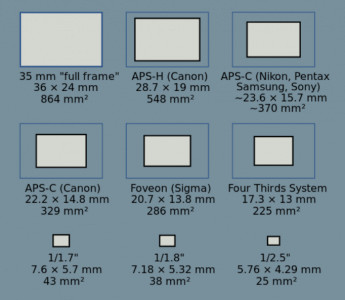 Sensor size comparison for different camera types
Sensor size comparison for different camera types
Sensor size comparison for a variety of camera types, illustrating the relative size differences between Full Frame, APS-C, Micro Four Thirds and point-and-shoot sensors.
Trade-off: Larger sensors typically mean higher camera prices and larger, heavier lenses.
Full-frame sensors are commonly found in professional-grade cameras, offering the highest image quality but often at a premium price and larger size. APS-C sensors are prevalent in many consumer DSLRs and larger mirrorless cameras, striking a balance between image quality and size. Micro Four Thirds sensors are smaller than APS-C but still significantly larger than those in point-and-shoot cameras and smartphones. Modern smartphone sensors, even in high-end models, remain considerably smaller than these dedicated camera sensor sizes.
Lens Quality and Features
After the sensor, the lens is arguably the next most impactful factor on image quality. Lenses are pure physics; they bend light to focus it onto the sensor. A crucial point is that, on average, larger sensors necessitate larger lenses to maximize their potential. Therefore, while larger sensors offer superior image quality, the lens size and weight trade-offs must be considered.
Trade-off: Lens size and weight are inversely related to zoom range and lens speed (maximum aperture). High-zoom lenses or “fast” lenses with wide maximum apertures tend to be larger and heavier.
Traveling with bulky, heavy lenses can be cumbersome.
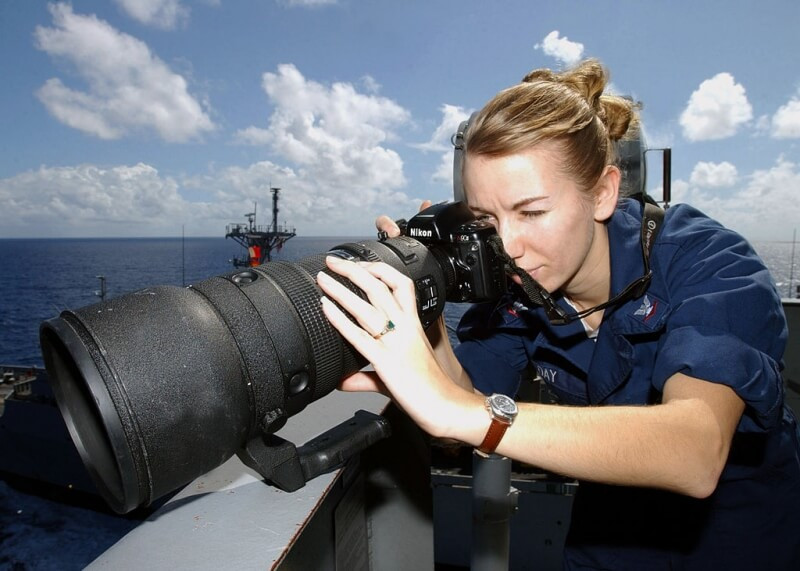 US Navy member with a large telephoto lens
US Navy member with a large telephoto lens
US Navy member Sabrina Day using a large 400mm fixed telephoto lens aboard an aircraft carrier, highlighting the size and specialized use of such lenses.
Interchangeable Lenses (ILC)
The ability to change lenses is a game-changer for versatility. Interchangeable Lens Cameras (ILCs) allow you to select the ideal lens for specific shooting scenarios.
Trade-off: Carrying multiple lenses increases versatility but also adds to the overall weight and bulk of your camera gear.
Interchangeable Lens Cameras (ILCs) empower you to choose the right lens for each photographic opportunity, adapting to diverse travel scenarios.
Image Stabilization (IS)
Image stabilization is invaluable when traveling, as tripods are often impractical. Effective IS minimizes camera shake, enabling sharper images, especially in low-light conditions. While it won’t freeze motion blur from moving subjects, IS is excellent for capturing steady landscapes or cityscapes at slower shutter speeds.
Trade-off: Image stabilization typically adds to the cost and complexity of a camera, with newer, often pricier models featuring more advanced IS systems.
This handheld shot of the Boston skyline demonstrates the effectiveness of image stabilization.
 Boston skyline handheld panorama
Boston skyline handheld panorama
Example of a handheld panorama of the Boston skyline, showcasing the benefit of image stabilization in low-light urban photography.
Size and Weight
For travel photography, size and weight are critical. A compact and lightweight camera is easier to pack, carry, and use discreetly, which is beneficial for both convenience and street photography. Many people buy bulky DSLRs only to leave them at home due to their size and weight.
Trade-off: Smaller cameras often mean smaller sensors and fewer features. Viewfinders, tilting screens, and readily accessible controls might be sacrificed in ultra-compact designs.
Manual Settings and Control
Manual settings provide creative control over your photographs. Even if you primarily use automatic modes initially, you’ll likely want to explore aperture priority or full manual mode as you grow more comfortable with photography. A good travel camera should offer easy access to these controls.
Trade-off: Cameras with comprehensive manual controls usually require a slightly larger body to accommodate physical dials and buttons. The smallest cameras might bury manual settings within menus, making them less accessible and user-friendly.
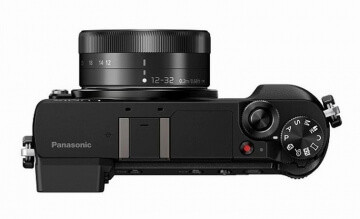 Camera with manual control dials
Camera with manual control dials
Close-up of a camera body showing dedicated dials for manual settings, emphasizing the importance of tactile controls for photographers who prefer manual adjustments.
Wireless Connectivity
Built-in Wi-Fi or Bluetooth is highly convenient for travelers. It enables quick photo transfers to smartphones for immediate sharing online, a significant advantage when traveling and wanting to share experiences in real-time.
Trade-off: Wireless connectivity is now common, but more advanced and reliable systems are often found in newer and potentially more expensive cameras.
Cost
Budget is a major consideration for most photographers. Especially for travel cameras, which are more susceptible to loss, damage, or theft, a mid-range camera often strikes a better balance than the most expensive, top-of-the-line models.
Trade-off: Cost involves personal priorities. Saving money on a camera might mean sacrificing some features or experiences elsewhere in your travels. Conversely, investing heavily in camera gear might increase anxiety about its safety while traveling.
Bonus Features: Nice-to-Haves for Travel
Beyond the core features, some bonus features can enhance the travel photography experience. Consider if any of these are particularly important for your needs.
Video Capabilities: Most modern cameras offer video recording, with some supporting 1080p and others 4K. While 4K video might not be essential for primarily still photographers, video image stabilization is a significant benefit for smoother, more professional-looking travel videos.
In-Camera HDR and Panorama: These features are standard on smartphones, and having them built into a dedicated camera streamlines workflow. In-camera processing saves time editing later, allowing for more time spent shooting and less time in front of a computer.
In-camera features simplify post-processing, maximizing your time behind the camera and minimizing time spent editing.
Weather and Water Resistance: Weather-sealed cameras offer protection against dust and moisture, ideal for adventurous travel in varied climates. While fully waterproof cameras involve further trade-offs, weather resistance adds durability and peace of mind.
Portability Enhancements: Small conveniences can make a big difference. USB charging, for example, allows you to charge your camera using standard phone chargers or portable power banks, simplifying charging logistics while traveling.
The Best Camera For Travel 2024: Panasonic Lumix GX85/GX80
The top recommendation for the best travel camera currently is the Panasonic Lumix GX85/GX80.
This mirrorless Micro Four Thirds camera with interchangeable lenses offers an excellent combination of features in a compact, travel-friendly body. Its rangefinder-style design is both stylish and functional, packing a powerful set of capabilities ideal for travel photography.
Buy the Panasonic Lumix GX85 Now
Let’s examine how the Panasonic GX85 excels in the key features discussed earlier, making it a standout travel camera.
Sensor Size: Perfectly Balanced
The Panasonic GX85 utilizes a Micro Four Thirds sensor. It’s not the largest sensor available, but it’s significantly larger than compact camera and smartphone sensors, offering a sweet spot in size and image quality.
For perspective, the Micro Four Thirds sensor is approximately 13 times larger than a typical iPhone sensor and about twice the size of higher-end point-and-shoot camera sensors. This larger surface area gathers significantly more light, contributing to improved image quality, especially in low-light conditions and with greater dynamic range.
While entry-level DSLRs and APS-C mirrorless cameras offer larger sensors, the Micro Four Thirds system strikes a compelling balance. Consider the sensor size comparison again:
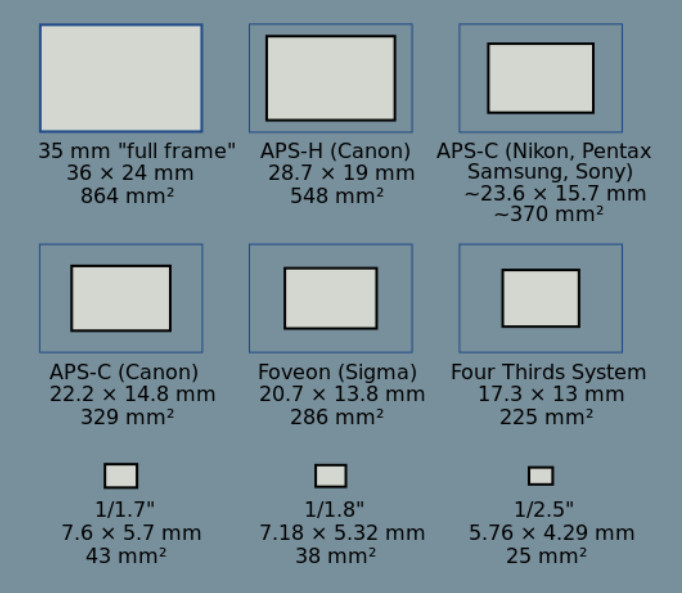 Sensor sizes comparison graphic
Sensor sizes comparison graphic
The seemingly modest difference in sensor size between APS-C and Micro Four Thirds translates to a substantial advantage in lens size and weight. Micro Four Thirds lenses are considerably smaller and lighter than equivalent lenses for DSLR and APS-C mirrorless systems. This size and weight reduction is a major benefit for travel photographers prioritizing portability.
Lens Versatility: Choose the Right Lens for Your Trip
When selecting a single lens for travel, a versatile zoom lens is often the most practical choice. A focal range equivalent to 24-70mm (in 35mm full-frame terms) is generally considered ideal for covering a wide range of travel photography scenarios. This range is suitable for landscapes, portraits, and general everyday photography.
Many kit lenses included with cameras cover this focal range. Even fixed-lens compact cameras, like the Canon G7x Mark III, offer similar coverage, with the Canon G7x Mark III extending to an equivalent of 24-100mm.
For a visual understanding of different focal lengths, Nikon provides a helpful lens simulator where you can experiment with various lens ranges and see their effects.
Interchangeable Lenses: Adapt to Any Situation
However, a single zoom lens might not suffice for all travel photography needs. Imagine being on safari and wanting to photograph wildlife at a distance. For situations requiring specialized lenses, interchangeable lens cameras are essential.
Think of lenses like shoes for different travel scenarios. Would you pack only one pair of shoes for exploring European cobblestone streets, relaxing on Caribbean beaches, and hiking through rainy trails? Likely not. Similarly, interchangeable lenses allow you to equip your camera for diverse photographic challenges.
For everyday sightseeing, a compact, lightweight “walkaround” lens is ideal. This is how the GX85 appears with a smaller lens:
For low-light photography, a fast prime lens (with a wide maximum aperture) excels. And for dedicated photography outings, a longer zoom lens expands creative possibilities. Here’s the GX85 transformed with a zoom lens:
This versatility is a key strength of the Micro Four Thirds system. It offers the smallest interchangeable lens camera system, resulting in a more compact overall kit compared to APS-C or full-frame systems.
The Micro Four Thirds system is the most compact interchangeable lens system available, offering significant portability benefits.
Furthermore, the Micro Four Thirds mount is a collaborative standard between Olympus and Panasonic, meaning lenses from both brands are compatible with Panasonic GX85 cameras. This expands lens choices considerably, with over 80 Micro Four Thirds lenses available from various manufacturers like Tamron and Sigma.
If the vast lens selection seems overwhelming, a curated shortlist of excellent Micro Four Thirds lenses for travel photography is available here.
Best Compact Travel Camera
If you prefer the simplicity of a fixed-lens camera and know you won’t need interchangeable lenses, the Canon G7x Mark III is an outstanding compact travel camera choice.
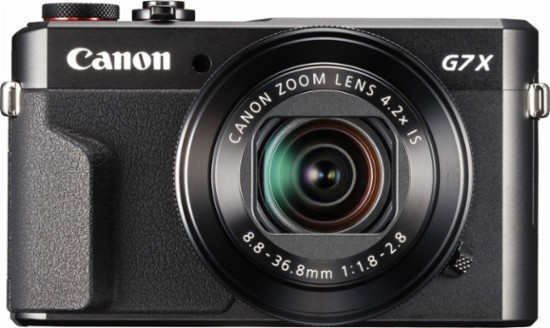 Canon G7x Mark III: Best Compact Travel Camera
Canon G7x Mark III: Best Compact Travel Camera
Buy the Canon G7x Mark III now
For a compact camera, the G7x Mark III features a large 1-inch sensor, among the largest sensor sizes in the compact camera category. It delivers excellent image quality in a pocketable form factor.
Bag Recommendation: Consider a DIY Camera Bag solution to ensure your compact camera is always accessible.
The lens boasts a versatile 24-100mm equivalent zoom range and a bright aperture of f/1.8-2.8, making it excellent for low-light shooting and achieving shallow depth-of-field effects.
Wired Magazine hailed the Canon G7x Mark II (predecessor to Mark III) as “likely to be the best pocket camera Canon has ever produced.”
The G7x Mark III includes a 180-degree tilting screen for vlogging and selfies, in-camera USB charging, and overall delivers exceptional image quality in a truly compact package. However, it remains a fixed-lens camera, limiting lens versatility.
Portability: Designed for Travel
As discussed, the Micro Four Thirds system inherently contributes to smaller, lighter camera setups. Within the Micro Four Thirds range, the Panasonic GX85 stands out as particularly compact.
Upon purchasing the GX85 as a potential replacement for a Canon 70D DSLR, its surprisingly small size became apparent – it’s compact enough to potentially replace a point-and-shoot camera as well.
The GX85 features a built-in electronic viewfinder (EVF), beneficial for composing shots in bright sunlight, and an articulating screen for flexible shooting angles. While not a full 180-degree flip-out screen, it’s highly useful for high and low-angle perspectives, encouraging more creative compositions.
A smaller camera also offers discretion, especially in situations where large cameras might attract unwanted attention. In crowded markets or culturally sensitive locations, a less conspicuous camera can be advantageous.
The GX85’s USB charging capability is another significant travel-friendly feature. Using a standard micro-USB cable, you can charge the camera from various sources, including portable power banks, eliminating the need for proprietary chargers and simplifying charging while on the go.
Image Stabilization: Handheld Stability
Image stabilization is a feature that significantly enhances travel photography. The GX85, when paired with stabilized lenses, offers impressive 5-axis sensor-shift image stabilization, providing up to 4 stops of stabilization.
This advanced IS system allows for remarkably sharp handheld shots at slower shutter speeds, even in low-light conditions. It opens up creative possibilities for capturing long exposures without a tripod.
While quantifying the exact benefit is challenging, the image stabilization in the GX85 enables handheld shots previously impossible with cameras lacking such advanced IS. The technology has progressed to the point where photographers are even capturing handheld shots of the Milky Way.
Full Manual Control: Creative Freedom
For photographers who want creative control, manual settings are essential. The GX85 provides the same level of manual control as a DSLR, with readily accessible dials and buttons for adjusting aperture, shutter speed, ISO, and other settings. This tactile control is crucial for quickly adapting to changing lighting conditions and creative visions.
The intuitive user interface of the GX85 is particularly important in a smaller camera body, ensuring that accessing and adjusting settings remains efficient and frustration-free.
This level of manual control is a key differentiator between dedicated cameras and smartphones. While some smartphone apps offer limited manual settings, the tactile and intuitive controls of a camera like the GX85 provide a far superior user experience for manual photography. However, if you primarily use automatic modes and don’t plan to explore lenses, a smartphone might suffice.
Wireless Sharing: Post On the Go
For those who share photos online, wireless connectivity is a valuable feature. The Wi-Fi on the Panasonic GX85 functions effectively for transferring images to smartphones for quick sharing. While Wi-Fi implementation on cameras can sometimes be a bit clunky, the GX85’s system is functional for transferring JPEGs or RAW files and even geotagging images if the GPS logger is activated.
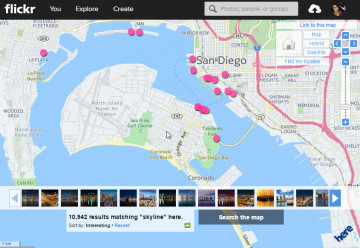 Flickr Map of San Diego
Flickr Map of San Diego
Example of a Flickr map displaying geotagged photos from San Diego, illustrating the appeal of location-based photo organization.
While seamless GPS tagging like smartphones offer is still not universally implemented in cameras, the ability to transfer photos wirelessly for quick sharing is a significant advantage for travel photographers.
Areas for Improvement
To provide a balanced perspective, some aspects of the GX85 could be improved. Its extensive feature set can be slightly complex, with some features mutually exclusive, such as HDR mode being unavailable in burst mode or RAW-only capture. While these limitations are often logical from a technical standpoint, they can be initially confusing in the field.
The touchscreen sensitivity can also be a minor annoyance. Accidental touch activation, even from a nose touching the LCD while using the viewfinder, can inadvertently change focus points. Disabling most touchscreen functions might be necessary to prevent this. Optimized touchscreen design could improve usability in future iterations.
Battery life is another area for potential improvement. The GX85’s battery life is adequate but not exceptional, often requiring spare batteries for extended shooting days. Carrying extra batteries is recommended.
Cost: Exceptional Value
The price point of the GX85 is a major highlight. It offers remarkable value for its class, often competing in price with cameras in lower categories. Bundled kits, including the body and two lenses (12-32mm pancake and 45-150mm zoom), are frequently available at very affordable prices.
Wired Magazine aptly described the Panasonic GX85 as “The Best Camera For The Money.”
Previously, a camera feature search on DPReview (now discontinued) highlighted the GX85 as a standout option in its price range, with only the older and larger Olympus OM-D E-M10 appearing as a close competitor.
The GX85’s combination of features and affordability makes it not only the best mirrorless travel camera but also the best budget travel camera overall.
A True Gem for Travel Photography
In conclusion, the Panasonic GX85/GX80 is an exceptional travel camera. It meets and exceeds the key feature requirements for frequent travelers, offering a compelling blend of portability, versatility, image quality, and value. Switching from a larger DSLR to the compact GX85 can be a liberating experience for travel photographers.
Note that the GX85 is marketed as the GX80 in Europe. Additionally, the Panasonic G85 is a different, larger DSLR-style camera. A comparison of the GX85 and G85 is available for those considering both models, but they are distinct cameras.
As the best mirrorless camera for travel, the Panasonic GX85/GX80 unequivocally earns the title of Best Camera For Travel in 2024.
Ready to make a purchase? Buy the Panasonic Lumix GX85 now
If you remain unconvinced about interchangeable lenses, the Canon G7x Mark III is a superb compact camera alternative, representing the best compact camera for travel.
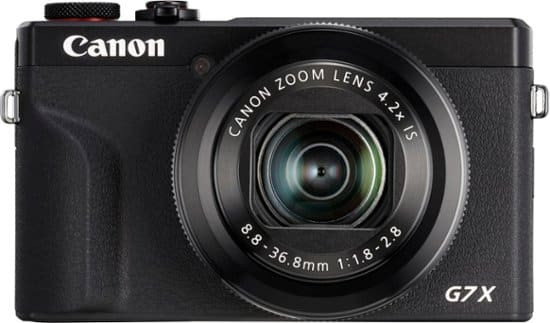 Canon G7x Mark III: Best Compact Travel Camera 2024
Canon G7x Mark III: Best Compact Travel Camera 2024
Buy the Canon G7x Mark III now
This post contains affiliate links. As an Amazon Associate, I earn from qualifying purchases. The opinions expressed here are entirely my own.
Essential Accessories for the GX85 – Already own the GX85? Explore recommended accessories like grips, batteries, and lenses.

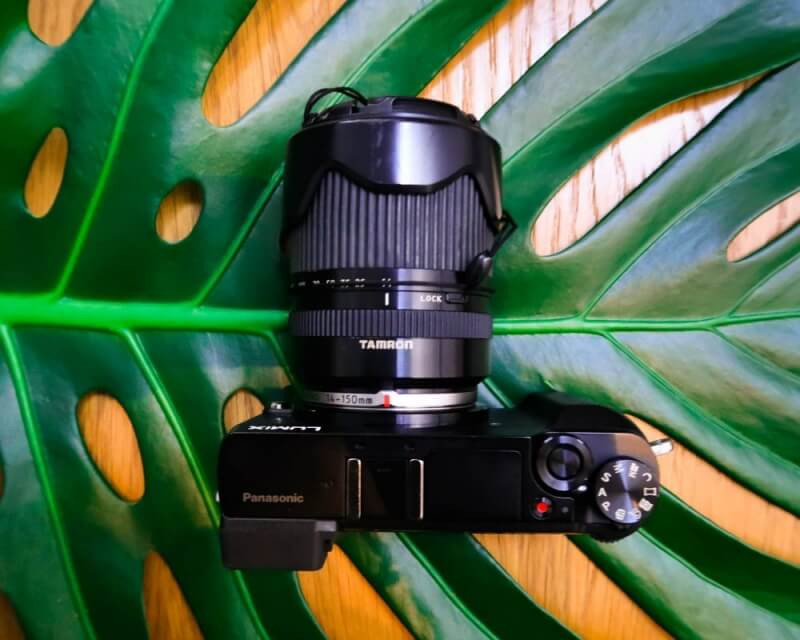 Panasonic GX85 with zoom lens
Panasonic GX85 with zoom lens